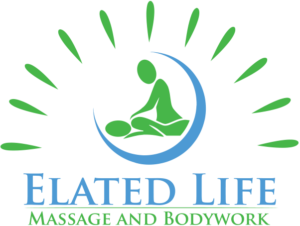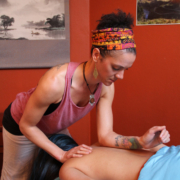9 Ways to Improve Your Posture
Do you feel like you are slowly growing a hunchback, or you are turning into a turtle? As a massage therapist I work with many clients who struggle with this type of poor posture due to sitting at a computer all day, looking at their phones, and moms who are always looking down at their little ones and constantly picking them up. Having poor posture can create imbalances in your body that can lead to tension and discomfort in your shoulders and neck, tension headaches, pain in your back and arms, and can be detrimental to one’s success in sports and athletic activities.
9 Great Ways to Improve Your Posture
Exercise for Better Posture
There are many reasons why the majority of us walking around have poor posture, but what are we doing about it? Most of us just accept it and move on. One of my goals is to help my clients gain a better understanding and awareness of their bodies so that they have better posture and in turn, feel better in their bodies and about themselves. Have you ever heard the saying, “how we hold ourselves reflects how we feel.”
The best way to feel our bodies and improve posture is through exercise. But there are many forms of exercise and not all support good posture. So focus on your core.
Strengthen your Core to Improve your Posture
Your core muscles are your foundation. These support the natural S-curve in your spine, and keep your body properly aligned in order to have functional movements and healthy range of motion in your joints. Having a strong core helps you stand upright, rather than slouch, without effort.
Your core is not just your 6 pack, but rather a group of muscles supporting your spine and thorax. So sit-ups are not going to cut it. Yoga and Pilates are great way to strengthen your core because they work with the whole body system, including strengthening and lengthening the core muscles. You don’t have to spend money on a membership, go to YouTube and look up yoga for core strengthening or Pilates for posture improvement.
Other Ways to Improve Posture
We spend most of our days in the same positions, doing the same movements repetitively. This overworks certain muscles, leaving them tight and shortened, while over-stretching and weakening the opposing muscles that maintain balance. So if you sit at a computer all day with your head and chest hunched forward, finish your day lying on a yoga ball with your arms up opening your chest and neck, or lie on a foam roller with your arms out in a T and your head hanging back for five minutes.
Rolling on a foam roller is also helpful, but it is important to give the muscles that have been turned on all day a chance to let go, so take your time. Other ways to improve posture include getting a stand up desk and avoid sitting for long periods of time, spending less time looking at your smartphone, standing with a straight back, or lying on the floor and pushing your back into the ground. If you have kids, it is important to be aware of your body. Don’t sacrifice your health for your child! If you are always looking down at them, pull your shoulders and chin back, and avoid constantly picking them up.
Massage for Better Posture
Exercise, body awareness, and stretching are important to keeping good, healthy posture. In addition, massage is an exceptional way to aid in reversing and preventing the hunchback by loosening, broadening, and stretching the muscles and connective tissue that are chronically tight, and getting circulation to the muscles that are stretch weakened.
Muscles Connected to Posture
Your core is an integral piece to maintaining good postural alignment, but what about the hunchback. This postural tendency, also known as kyphosis, is especially common amongst teenagers, moms, drivers, and people who work long hours sitting at computers. Hunching over to look at smartphones, low self-esteem, picking up babies and toddlers, breast-feeding, and staring at a computer screen in deep concentration for hours on end all do the same thing – shorten the muscles in your chest, and stretch weakening the muscles in your upper back. The common denominator is tension in between your shoulder blades.
The confusion lies in where you feel tension. The muscles in between your shoulder blades that are constantly aching are actually tired from being stretched and pulled. They are not strong enough to endure this stress. So not only do you want to strengthen your core, but you want to strengthen these muscles in the back, and stretch out the muscles in your chest.
Strengthen Trapezius for Posture
Your trapezius, or traps, is a diamond shaped muscle covering your upper back. It attaches to the bottom of your head, your neck, your shoulder blades, all the way down to T12 on your spine (located at the last rib). It has multiple functions, from extending the neck (looking up), and moving the scapula up and down, and rotating it upwards and inwards. The fibers of the traps run in three different directions making all of these movements possible.
This is a confusing muscle because it does so much. Basically, if you sit at a computer with your arms extended forwards, the upper fibers of the muscle are turned on. If you stand upright, with your shoulders pulled back and down, the middle and lower fibers are turned on. If the upper fibers are on for too long, they get tight and pull on your neck causing tension, which can create headaches and neck pain. Also, if you are hunched forwards all the time, the lower and middle fibers that help you stand upright stop working and become weak (as well as other muscles like the rhomboids and lats). So, you need to do specific exercises to strengthen them and create balance.
Pec Minor Strength for Improved Posture
The Pecs are located in the front of the chest. Pec Minor attaches to your coracoid process (on the scapula) and your 3rd through 5th rib. Its main function is to pull the scapula forwards and downwards, and assist in rotation. It also elevates the ribs during inhalation. The brachial plexus, the nerves and blood vessels that run from your neck to the upper arm, runs underneath the pec minor.
This muscle is overworked and shortened when our shoulders are hunched forward. If not stretched out regularly, it will become chronically tight, which in turn will pull on your rhomboids, and middle and lower traps, causing them to weaken, creating an imbalance. Having a shortened pec minor not only leads to kyphosis, but also can cause many issues including decreased range of motion in the shoulder joint, pinched nerves – tingling in the hands and fingers, arm pain, and difficulty breathing.
Pec Major Strength for Posture
The Pec Major is responsible for flexion (lifting the arm in front of you), extends the arm (opening the arm outwards), adduction (bringing the arm across the front of you), rotates the shoulder joint, and assists in inhalation. It attaches to the clavicle, the sternum from your 1st through 7th rib, and your humerus (upper arm bone). When we are hunched forward the pec major is shortened, pulling the shoulders forward, and rotating the arms inward.
In order to keep your pecs healthy and your upper body balanced, stretching and opening the chest is necessary. This will also help you breathe better, keeping you more in touch with your body and feeling good.
Massage Helps to Ease Tension in Tight Muscles
Now that you know a little about some of the muscles contributing to poor posture, let’s talk about how they can be addressed in massage. First, most people come in complaining about tension between their shoulder blades and in the back of their neck. As addressed before, this is due to the muscles being stretched weakened, and therefore not getting enough circulation and nutrients. Massage helps to bring all the good stuff back to those muscles, giving them freedom to move, creating balance, and helping to activate them so they can function properly.
Working on the specific muscles of the chest that were discussed previously as well as the connective tissue surrounding those muscles will bring about balance. Lengthening and broadening the connective tissue and pecs will help open up the chest, bring circulation to those muscles, and increase range of motion.
This will make the work you do on your own easier and more doable. If you are not able to open up your chest to comfortably lie with your arms in a T on your foam roller or yoga ball, then chances are you won’t do it. But if you get regular massage, with a focus on these areas, and your chest is able to open, then you will be more motivated to do the work yourself.
Find what works for you. Experiment. Eventually you will come up with a self-care routine to end your day that you are motivated to do, that makes you feel good, and supports healthy posture.
Have fun, breath, open your heart, and let go.



